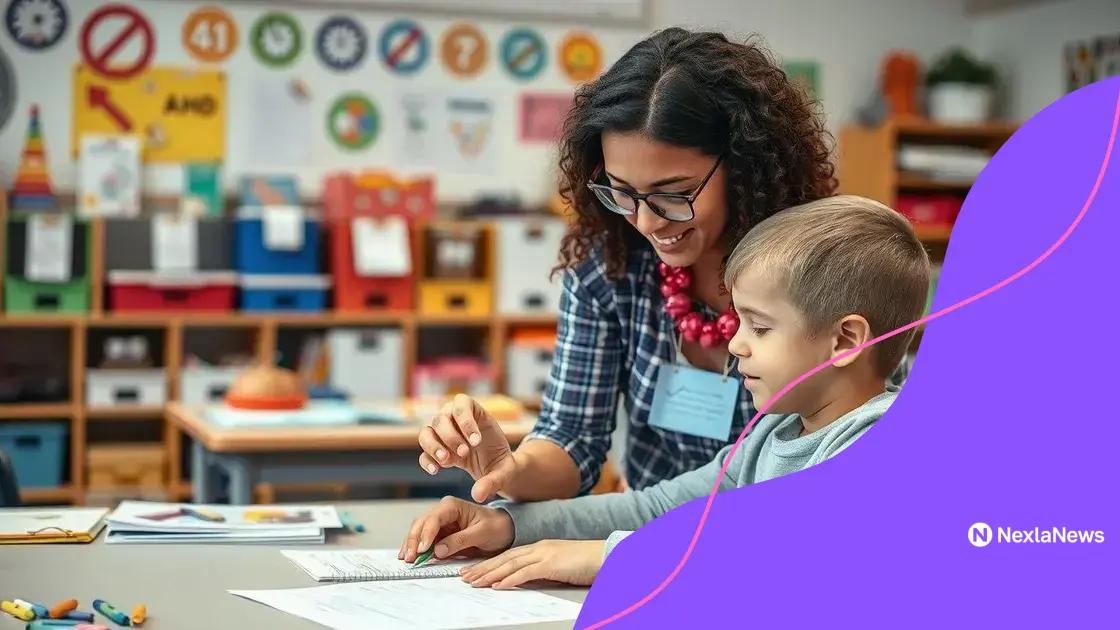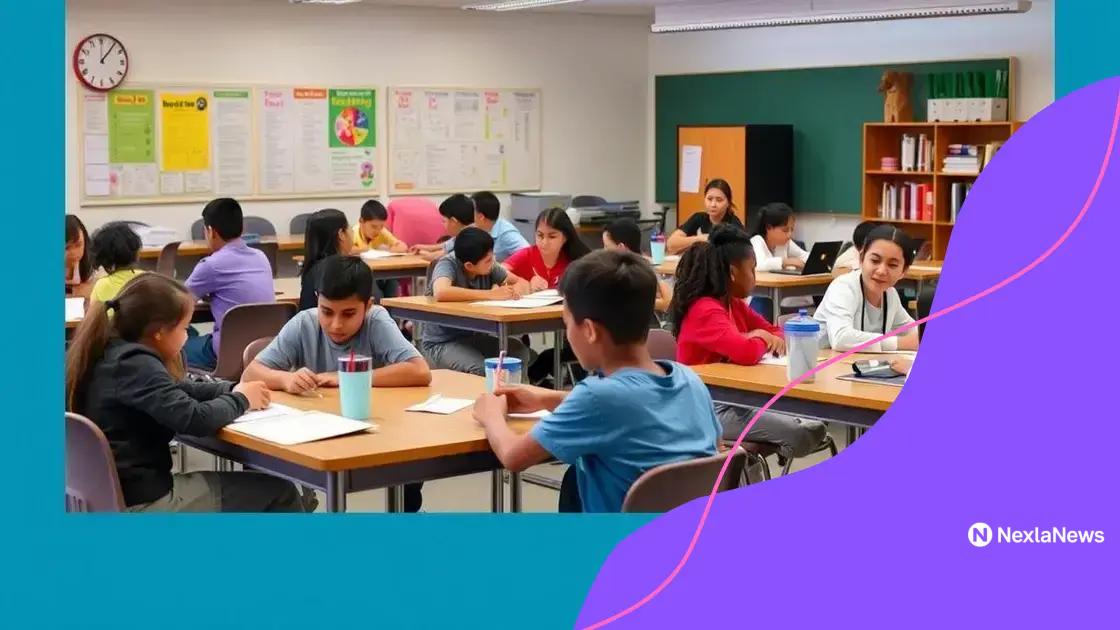Supporting students with ADHD can transform education

Supporting students with ADHD requires a collaborative approach involving tailored strategies, effective resources, and strong engagement from both teachers and parents to create inclusive learning environments.
Supporting students with ADHD is crucial for fostering their educational success. Have you ever wondered how tailored approaches can make a difference in their learning journey? Let’s explore.
Understanding ADHD in education
Understanding ADHD in education is vital for creating supportive learning environments. ADHD, or Attention-Deficit/Hyperactivity Disorder, affects many students, making it harder for them to focus. Recognizing its symptoms can help teachers provide the right support.
Students with ADHD often experience challenges such as difficulty staying organized, trouble following instructions, and impulsive behaviors. These symptoms can hinder their academic performance, leading to frustration.
Common symptoms of ADHD
It’s important to identify the key symptoms to understand how they impact learning. Here are some of the most common:
- Inattention: Difficulty focusing on tasks or instructions.
- Hyperactivity: Excessive movement and trouble sitting still.
- Impulsivity: Acting without thinking about the consequences.
- Disorganization: Struggling to keep track of assignments or materials.
Teachers and parents can work together to address these challenges. Open communication is crucial. Discussing behavioral strategies and sharing insights about the child’s experiences can lead to better solutions.
Strategies for understanding students with ADHD
Employing specific teaching strategies can greatly assist those with ADHD. Here are a few effective methods:
- Provide clear, concise instructions to limit confusion.
- Use visual aids to help students stay focused.
- Incorporate movement into lessons to engage energetic students.
- Break tasks into manageable segments to prevent overwhelming students.
By integrating these techniques, educators can help students better manage their ADHD symptoms. Tailoring instruction to suit each child’s needs supports their academic journey.
Understanding ADHD goes beyond recognizing symptoms; it requires empathy and patience. Special strategies can empower students, allowing them to thrive in an educational setting. Ensuring a nurturing atmosphere will improve not only their learning but also their well-being.
Strategies for effective classroom management
Strategies for effective classroom management are essential for creating a supportive environment. Teachers play a significant role in helping students with ADHD thrive. Understanding how to manage the classroom can lead to better learning experiences.
Establishing clear rules and expectations is a foundational strategy. When students know what is expected of them, they are more likely to succeed. Routine is also vital; having a structured day reduces anxiety for students with ADHD.
Implementing positive reinforcement
Using positive reinforcement can motivate students. Recognizing their strengths and achievements boosts their confidence.
- Give verbal praise to encourage good behavior.
- Implement a reward system for meeting goals.
- Celebrate small successes to build momentum.
Consistency is key in applying these strategies. When students know what to expect, they feel secure, which can enhance their focus. Staying on schedule also helps minimize distractions.
Creating a dynamic learning environment
The learning environment should cater to the needs of students with ADHD. Seating arrangements can impact focus and engagement. Flexible seating options allow students to choose how they learn best.
- Allow students to move around during lessons to stay engaged.
- Use interactive activities to promote participation.
- Incorporate technology to capture attention and facilitate learning.
Engagement is vital. When students are actively involved, they are less likely to distract themselves or others. Encouraging movement and participation can make lessons more effective.
By implementing thoughtful management strategies, teachers can create a more inclusive classroom. Working together with students and understanding their needs leads to a more effective learning atmosphere. The goal is to foster an environment that benefits every student, especially those with ADHD.
Creating inclusive learning environments

Creating inclusive learning environments is crucial for supporting all students, especially those with ADHD. An inclusive classroom promotes a sense of belonging and encourages participation. When students feel accepted, they are more likely to thrive academically and socially.
An inclusive setting starts with understanding the diverse needs of all learners. Each student brings unique strengths and challenges. When teachers recognize these differences, they can tailor their approaches to meet various needs.
Flexible classroom design
The physical arrangement of the classroom can significantly impact learning. A flexible classroom design allows for different seating arrangements that can cater to various learning styles. Consider these aspects:
- Different seating options, such as chairs, bean bags, or floor cushions, encourage comfort and focus.
- Creating quiet areas for students who need breaks can help reduce distractions.
- Using movable furniture helps adapt the space for group or individual work.
When students can choose their seating, they often feel more engaged and in control of their learning. This autonomy can be especially beneficial for those with ADHD, as it allows them to find their optimal environment for focus.
Diverse teaching strategies
Utilizing diverse teaching strategies is another key component of inclusivity. Incorporating different methods can address various learning preferences.
- Use visual aids and hands-on activities to enhance understanding.
- Integrate technology to facilitate learning and capture attention.
- Offer choices in assignments or projects to foster interest and motivation.
These approaches help students grasp concepts in multiple ways, ensuring that everyone has access to the learning material. Additionally, collaboration among students through group work promotes social skills and cooperation.
In conclusion, fostering an inclusive learning environment is all about understanding and valuing diversity. By creating spaces that accommodate different needs and offering varied instructional strategies, educators will empower students with ADHD and all learners to succeed. Implementing these ideas nurtures resilience and enhances the educational experience.
Engaging parents and caregivers
Engaging parents and caregivers is crucial for supporting students with ADHD. When families are involved, students often see improved academic performance and behavior. Creating strong partnerships with families can enhance the effectiveness of strategies used in the classroom.
One effective way to engage parents is through regular communication. Teachers should provide updates on student progress and behavior. This can help families understand what happens in the classroom and how they can support learning at home.
Building positive relationships
Establishing trust between educators and families is essential. When parents feel heard and valued, they are more likely to participate. Here are some strategies for building these relationships:
- Hold regular meetings or conferences to discuss student progress.
- Invite parents to participate in school events and activities.
- Use positive reinforcement when communicating with families, focusing on strengths.
These efforts show families that they are an integral part of the educational process. Parents who feel involved are more likely to advocate for their children and collaborate with teachers.
Providing resources and support
Another way to engage families is by providing valuable resources. Teachers can offer guidance on helping students with ADHD at home. Some useful resources include:
- Workshops on ADHD management strategies.
- Access to materials that explain ADHD and its impact on learning.
- Support groups for parents to share experiences and solutions.
By sharing these resources, educators empower parents and caregivers to take an active role in their child’s education. Supporting families outside the classroom ultimately benefits the student.
Involving parents and caregivers effectively can create a unified approach to education. When schools and families work hand in hand, students with ADHD can thrive both academically and socially. This partnership is key to fostering long-term success.
Resources for teachers and students
Resources for teachers and students are essential in supporting those with ADHD. Having access to various tools can help educators implement effective strategies and assist students in overcoming their challenges. The right resources also empower teachers to create an engaging and productive classroom environment.
One valuable resource is educational workshops. These workshops can provide teachers with actionable strategies for addressing the needs of students with ADHD. Not only do they learn practical techniques, but they also gain a deeper understanding of the disorder itself.
Useful online platforms
Several online platforms offer resources specifically tailored for ADHD. Here are some great options:
- CHADD (Children and Adults with Attention-Deficit/Hyperactivity Disorder): This organization provides information, resources, and support for educators.
- Understood.org: A comprehensive site offering resources for parents and teachers of children with learning disabilities, including ADHD.
- ADDitude Magazine: This publication offers expert advice on ADHD management for teachers and families.
These online platforms help educators find vital information, techniques, and community support to improve their teaching methods and help students thrive.
Classroom materials and tools
In addition to online resources, teachers can benefit from specific classroom materials. Implementing the right tools can enhance student engagement and learning. Consider these resources:
- Visual schedules to help students keep track of tasks and responsibilities.
- Fidget tools and sensory items to aid concentration and focus.
- Apps designed to promote organization and time management.
Having these tools accessible in the classroom supports students in managing their ADHD symptoms while maintaining focus on their studies. When equipped with effective resources, teachers can create a positive and inclusive learning atmosphere.
Ultimately, the right resources for teachers and students can bridge the gap for those with ADHD, creating pathways for success and understanding. By investing in these tools, educators can significantly enhance the educational experience for all students.
In conclusion, supporting students with ADHD requires a collaborative approach that involves educators, parents, and the students themselves. By understanding ADHD and implementing effective strategies, teachers can create inclusive learning environments that foster growth and success. Engaging parents and providing valuable resources further strengthens this support system, allowing students to thrive academically and socially. Together, we can empower students with ADHD to reach their full potential.
FAQ – Supporting Students with ADHD
What strategies can teachers use to support students with ADHD?
Teachers can use clear instructions, classroom management techniques, and flexible seating arrangements to help students with ADHD focus and engage.
How can parents get involved in supporting their children with ADHD?
Parents can communicate regularly with teachers, attend meetings, and participate in school events to enhance their child’s learning experience.
What resources are available for educators teaching students with ADHD?
Educators can access online platforms like CHADD and Understood.org, as well as tools like visual schedules and fidget devices, to support their students.
Why is creating an inclusive learning environment important for students with ADHD?
An inclusive environment helps students feel safe and accepted, fostering better academic performance and social interactions.
